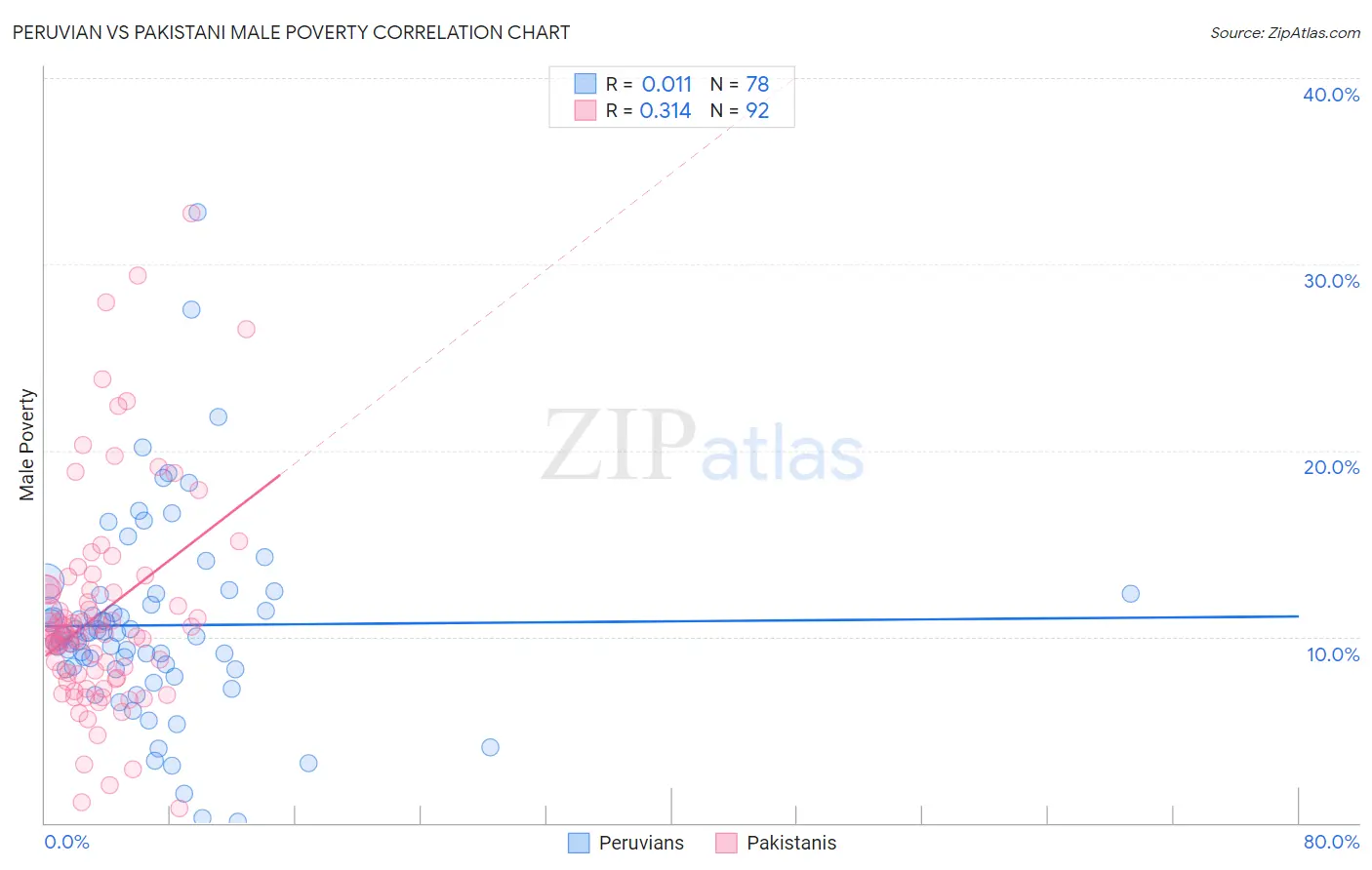Peruvian vs Pakistani Male Poverty
COMPARE
Peruvian
Pakistani
Male Poverty
Male Poverty Comparison
Peruvians
Pakistanis
10.7%
MALE POVERTY
87.1/ 100
METRIC RATING
121st/ 347
METRIC RANK
10.8%
MALE POVERTY
83.0/ 100
METRIC RATING
133rd/ 347
METRIC RANK
Peruvian vs Pakistani Male Poverty Correlation Chart
The statistical analysis conducted on geographies consisting of 362,866,213 people shows no correlation between the proportion of Peruvians and poverty level among males in the United States with a correlation coefficient (R) of 0.011 and weighted average of 10.7%. Similarly, the statistical analysis conducted on geographies consisting of 335,136,890 people shows a mild positive correlation between the proportion of Pakistanis and poverty level among males in the United States with a correlation coefficient (R) of 0.314 and weighted average of 10.8%, a difference of 0.83%.

Male Poverty Correlation Summary
| Measurement | Peruvian | Pakistani |
| Minimum | 0.066% | 0.75% |
| Maximum | 32.8% | 32.7% |
| Range | 32.7% | 32.0% |
| Mean | 10.6% | 11.2% |
| Median | 10.1% | 10.2% |
| Interquartile 25% (IQ1) | 8.3% | 7.9% |
| Interquartile 75% (IQ3) | 12.3% | 12.5% |
| Interquartile Range (IQR) | 4.0% | 4.6% |
| Standard Deviation (Sample) | 5.3% | 5.8% |
| Standard Deviation (Population) | 5.2% | 5.8% |
Demographics Similar to Peruvians and Pakistanis by Male Poverty
In terms of male poverty, the demographic groups most similar to Peruvians are Immigrants from China (10.7%, a difference of 0.010%), Native Hawaiian (10.7%, a difference of 0.020%), South African (10.7%, a difference of 0.060%), French (10.7%, a difference of 0.080%), and Immigrants from Hungary (10.7%, a difference of 0.11%). Similarly, the demographic groups most similar to Pakistanis are Immigrants from Vietnam (10.8%, a difference of 0.010%), New Zealander (10.8%, a difference of 0.010%), Brazilian (10.8%, a difference of 0.050%), Immigrants from Belarus (10.7%, a difference of 0.060%), and Chilean (10.7%, a difference of 0.17%).
| Demographics | Rating | Rank | Male Poverty |
| Immigrants | South Eastern Asia | 88.1 /100 | #117 | Excellent 10.6% |
| Okinawans | 87.6 /100 | #118 | Excellent 10.7% |
| Immigrants | Hungary | 87.6 /100 | #119 | Excellent 10.7% |
| Immigrants | China | 87.1 /100 | #120 | Excellent 10.7% |
| Peruvians | 87.1 /100 | #121 | Excellent 10.7% |
| Native Hawaiians | 87.0 /100 | #122 | Excellent 10.7% |
| South Africans | 86.8 /100 | #123 | Excellent 10.7% |
| French | 86.7 /100 | #124 | Excellent 10.7% |
| Immigrants | Norway | 86.0 /100 | #125 | Excellent 10.7% |
| Immigrants | Ukraine | 84.3 /100 | #126 | Excellent 10.7% |
| Puget Sound Salish | 84.3 /100 | #127 | Excellent 10.7% |
| Immigrants | Western Europe | 84.2 /100 | #128 | Excellent 10.7% |
| Immigrants | Peru | 84.1 /100 | #129 | Excellent 10.7% |
| Chileans | 83.9 /100 | #130 | Excellent 10.7% |
| Immigrants | Belarus | 83.3 /100 | #131 | Excellent 10.7% |
| Immigrants | Vietnam | 83.0 /100 | #132 | Excellent 10.8% |
| Pakistanis | 83.0 /100 | #133 | Excellent 10.8% |
| New Zealanders | 82.9 /100 | #134 | Excellent 10.8% |
| Brazilians | 82.7 /100 | #135 | Excellent 10.8% |
| Immigrants | Israel | 80.9 /100 | #136 | Excellent 10.8% |
| Immigrants | Switzerland | 79.2 /100 | #137 | Good 10.8% |